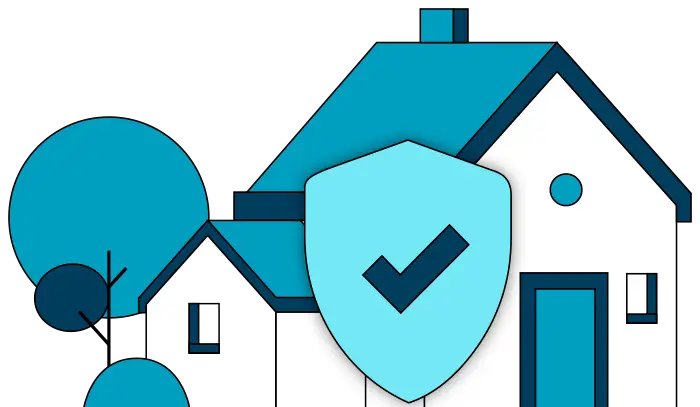When buying a home, one of the important decisions you have to make is what home insurance policy to purchase. Your mortgage lender will usually have specific requirements that you need to keep in mind, in addition to understanding your own coverage needs.
Standard home insurance has six types of coverage on each policy. Though some of these types of coverage have names more commonly used in the industry, companies described these six types alphabetically, as coverages A through F.

Each type of coverage plays its own role in providing comprehensive financial protection for you and your home. Understanding their distinctions and standard limitations will help you evaluate if a future or current policy is right for you and what policy changes you might need to request from your insurance company.
Coverage A – Dwelling Coverage
Coverage A, or dwelling coverage, is the central coverage included in a homeowners policy and will generally have the highest limit of types of coverage on your policy.
- What It Covers: Dwelling coverage protects the structural components of your home from damage and covers in the event of damage to the home that impacts walls, floors, ceilings, home systems, and more.
- When It Applies: This type of coverage will usually apply in the event of damage from a covered peril such as theft, vandalism, fire, explosions, windstorms, and lightning. Perils covered by Coverage A vary depending on the type of policy you have. HO-1 provides protection from 10 named perils. HO-2 protects from 16 named perils. Dwelling coverage in standard HO-3 and HO-5 policies protects from all risks on an open peril basis, except for exclusions.
- Standard Coverage: Coverage A can have any limit and it is generally recommended that homeowners carry Coverage A which protects the full replacement cost of their home. Many insurance companies offer upgrades such as extended replacement cost and guaranteed replacement cost which can further increase your dwelling coverage limit.
- Add-On Coverage You Might Need: If you live in an area with higher risks of floods or earthquakes, you may need to purchase add-on coverage in the form of a rider or additional policies. These add-ons will protect your home against structural damage from these kinds of natural disasters as they are not covered under standard Coverage A.
Coverage B – Other Structures Coverage
- What It Covers: Coverage B applies to structures independent of your home, like fencing, detached garages, swimming pools, sheds, driveways and more.
- When It Applies: Coverage B applies under similar circumstances as does Coverage A, including damage from theft, vandalism, fire, explosions, windstorms, and lightning. Similarly to dwelling coverage, the perils covered will depend on the policy type you have. HO-1 and HO-2 policies provide named peril protection, while HO-3 and HO-5 have open-peril coverage for other structures.
- Standard Coverage: Standard policies will usually limit Coverage B to 10% of the replacement cost of the home, which is also the general industry’s minimum recommendation for homeowners. If you know that your detached structures are worth more, consider increasing your Coverage B limit to 25% or more.
- Add-On Coverage You Might Need: Depending on your home’s circumstances, including location, you might want to request a higher limit for Coverage B. Additionally, some insurance companies will have different policies and may require you to get separate coverage for your pool.

Coverage C – Personal Property Coverage
More commonly referred to as personal property coverage, Coverage C deals with all the belongings in your home.
- What It Covers: Personal property coverage protects the belongings found within the home that don’t fall outside the stipulations in the policy, such as items in certain categories or that are too valuable and need their own policies.
- When It Applies: Personal property coverage applies when the inside of the home sustains damage, such as during a fire or from water damage. HO-1 policies typically don’t cover your personal belongings. HO-2 and HO-3 policies cover your personal property from 16 named perils. Only HO-5 provides open-peril coverage for this section.
- Standard Coverage: Personal property coverage tends to range from 20% to 50% of the total replacement cost under Coverage A.
- Add-On Coverage Available: Personal belongings in certain categories, such as artwork, firearms, and jewelry, will have specific monetary caps on how much can be paid out for claims. If you want additional coverage, you can purchase add-on valuable items coverage from many insurance companies. You can also upgrade your personal property to provide replacement cost coverage.
Coverage D – Loss of Use Coverage
Loss of use refers to when the insured home is damaged to the point that it cannot be lived in. Loss of use coverage is also known as additional living expenses coverage.
- What It Covers: Loss of use covers additional living expenses, including housing expenses and in-excess of normal food costs when the insured property cannot be used. It can also cover lost income from rental properties that are unlivable.
- When It Applies: Loss of use coverage applies when a home is a total loss after damage and is unlivable, and it covers the temporary housing and additional living costs (such as food).
- Standard Coverage: Loss of use coverage covers costs of temporary housing for the entire time that the insured property is being repaired or rebuilt.
- Add-On Coverage Available: N/A
Coverage E – Personal Liability Coverage
- What It Covers: Personal liability coverage protects a homeowner from financial responsibilities of paying for a property or medical bills resulting form property damage or injury from the accidents caused by the homeowner or a member of their household.
- When It Applies: Coverage E applies in cases where the homeowner is at fault (or liable, when negligence has caused a loss due to property damage or injury. Liability coverage does not apply for things that the homeowners or household members did not cause or did deliberately.
- Standard Coverage: Standard policies include $100,000 worth of liability coverage.
- Add-On Coverage Available: Homeowners are advised to carry $300,000 to $500,000 worth of liability coverage, for which they would have to purchase additional liability insurance.
Coverage F – Medical Payments to Others
It’s important to understand that, though they both can cover medical bills due to injury, medical coverage F and liability coverage can apply in overlapping scenarios but each has distinct stipulations and limitations.
- What It Covers: Medical coverage pays for medical bills of a person injured on the insured property.
- When It Applies: Medical coverage applies when a person is accidentally injured and the claim is less than the maximum coverage limit.
- Standard Coverage: Standard policies include medical coverage of between $1,000 and $10,000.
- Add-On Coverage You Might Need: Medical coverage can range, but the amount is generally determined by what each state requires, as well as what the home insurance company whose policy you are dealing with offers.
Additional Coverages and Endorsements
Many times, the limits and covered perils are not enough to make you feel safe. In this case, there are several additional coverages you can apply to your policy to provide you with all-encompassing protection.
Standard policies will not cover costs due to damage caused by: floods, earthquakes, landslides, mold, pests, and general wear and tear. If you’re in a low-terrain area prone to flooding, it’s a good idea to tack on some flood insurance to your policy. The same goes for areas susceptible to earthquakes or cave-ins.
Here is a list of popular additional coverages and endorsements that you can purchase to further protect your home:
- Flood insurance
- Earthquake or earth movement insurance
- Inflation guard
- Water and sewer backup endorsement
- Extended personal liability
- Coverage for high-value items like jewelry, art, watches, antiques, etc.
- Identity theft
- Home business endorsement
- Watercraft endorsement
- Assisted living care coverage
- Equipment breakdown coverage
Other endorsements include damage caused by sewage backup and extended personal liability. Some insurers push the envelope even further and offer add-ons that help pay for valuables like antiques and jewelry or help pay for a new roof if the situation requires.
Actual Cash Value (ACV) vs. Replacement Cost Value (RCV)
Regarding your dwelling coverage and personal property, insurance companies typically look at how much your property and items are worth. Replacement cost, conveniently enough, refers to the amount of money it costs to replace your home and items within. For a standard insurance policy, an additional premium is added for this broader coverage.
Paying close attention to the verbiage for your replacement cost matters. Your insurer may only reimburse you for the actual cash value instead of the total replacement cost value of your property.
ACV is determined by taking the cost of replacing your home and subtracting the value of depreciation. This means general wear and tear, age, and other factors may take away from the total replacement cost of your home.
A replacement cost policy pays for the repair or replacement of damaged property with materials similar to the original ones. Replacement cost differs from ACV in that it doesn’t account for depreciation. That said, replacement cost value will pay for your damaged belongings, whether they were brand new or 20 years old.
Extended and Guaranteed Replacement Cost
If you’re worried about your standard replacement cost not being high enough, you may consider adding an extra security blanket. Extended replacement cost is available to many policyholders for an extra fee.
Extended replacement cost extends the amount covered by your Coverage A. This is usually a certain percentage more than your policy. For example, a 10% extended replacement cost will turn your $100,000 policy into a $110,000 policy.
Let’s say the damage done to your home is more than the limits of your policy and the extended coverage. In this case, guaranteed replacement cost is the better solution.
Guaranteed replacement cost is only offered by a handful of companies, but it’s more extensive than other endorsements. This extension covers the cost to replace your home and the items within, regardless of your policy’s limitations.
Types of Homeowners Insurance Policies
An HO-2 policy will take care of certain coverages that an HO-1 policy won’t. Understanding what this means can help you decide what kind of policy, coverage, and endorsements are right for you.
- HO-1 is the Basic Form. It’s the simplest kind of insurance you could ask for. It covers a handful of potential risks and usually only encompasses your dwelling protection. Typically, only coverage A and B are included in HO-1.
- HO-2 is the Broad Form. It typically includes all 6 coverages A, B, C, D, E, and F. This policy covers your home from the perils found in HO-1, plus:
- Falling objects, like trees and electrical poles.
- HO-3 is called the Special Form. HO-3 is a hybrid open-peril and named-peril policy. HO-3’s dwelling and other structures coverages protect homeowners on an open-peril basis. However, personal property coverage protects your belongings from 16 named perils. It is important to note that there are still perils excluded from dwelling and other structures coverage such as neglect, wear and tear, earthquakes, and floods. HO-3 policies include all 6 Coverages A, B, C, D, E, and F.
- HO-4 is how the insurance world refers to Renters Insurance. It only encompasses Coverages C and E. Sometimes, Coverage D is offered as well.
- HO-5, or the Comprehensive Form, is similar to HO-3 but adds open-peril coverage for personal property. Another difference is, HO-3 typically provides an actual cash value coverage for personal belongings, while HO-5 bumps it up to the replacement cost value coverage C.
- HO-6 is Condo Form insurance. This policy uses the same coverage as HO-4, except HO-6 will still include dwelling coverage A which is supposed to work in conjunction with the HOA master policy and cover what is not covered by your HOA’s insurance.
- HO-7 is the Mobile Home Form, which is used if you own a manufactured or mobile home. Much like HO-4 and HO-6, HO-7 uses Coverages A, B, C, E, and sometimes D. The difference is, the HO-7 is specifically tailored to unique events that occur in a mobile home.
Conclusion
We know that homeowners insurance can seem a little bit confusing. That’s why we’ve broken down the basics of home insurance for you.
Obviously, understanding each of these six types of coverage will help you evaluate your current or future policy and if it fits your needs. Make sure to ask any insurance agent or broker who is helping you find a policy about the conditions and limits of each type of coverage so you understand the potential changes and additional costs you might need to add to each policy.
With the right policies and endorsements in place, you can keep your property safe from the elements and other unexpected disasters. Knowing the difference between an HO-1 and an HO-3 will help you make the right choices and reduce your worries about how you’re going to pay for future repairs.
This info should get you started on the right path toward protecting yourself and your home. Now you know what to look for, and how to keep your home (and your wallet) safe.

